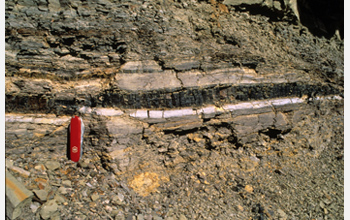Multimedia Gallery
The K-Pg boundary as exposed along the side of Interstate 25 near Raton Pass in southern Colorado.
The K-Pg boundary as exposed along the side of Interstate 25 near Raton Pass in southern Colorado. The obvious white layer is the K-Pg ejecta layer. It contains elevated levels of iridium and shocked mineral grains. Pollen and spores from Cretaceous plants are found immediately below this layer but not above it, a pattern that is seen from the southern United States all the way north to the Arctic Ocean. This direct link between impact ejecta and plant extinction suggests a very strong cause and effect relationship between impact and extinction.
Credit: Kirk Johnson, Denver Museum of Nature & Science
Images credited to the National Science Foundation, a federal agency, are in the public domain. The images were created by employees of the United States Government as part of their official duties or prepared by contractors as "works for hire" for NSF. You may freely use NSF-credited images and, at your discretion, credit NSF with a "Courtesy: National Science Foundation" notation.
Additional information about general usage can be found in Conditions.
Also Available:
Download the high-resolution JPG version of the image. (3.5 MB)
Use your mouse to right-click (Mac users may need to Ctrl-click) the link above and choose the option that will save the file or target to your computer.
Related story: Revisiting Chicxulub



